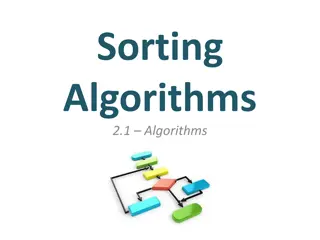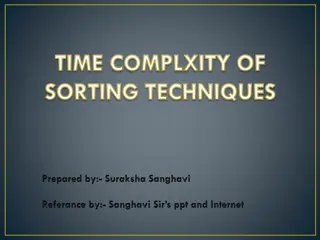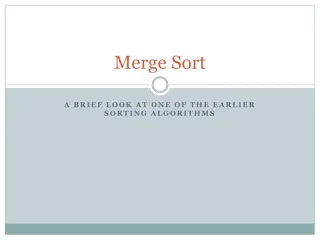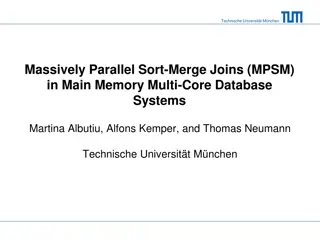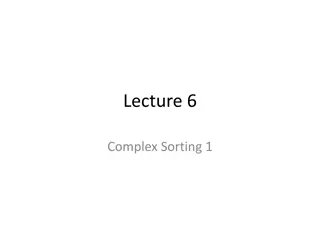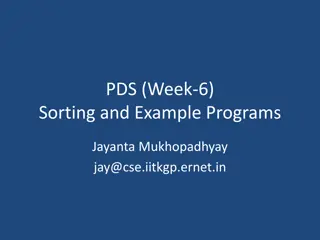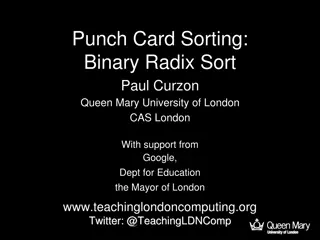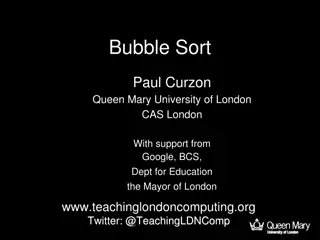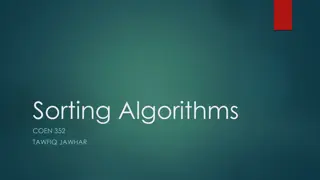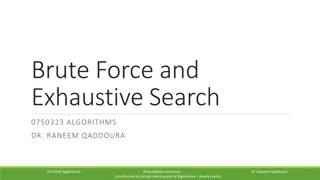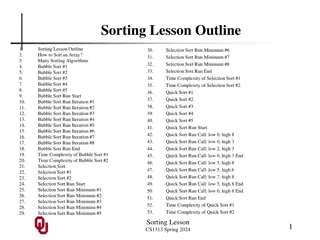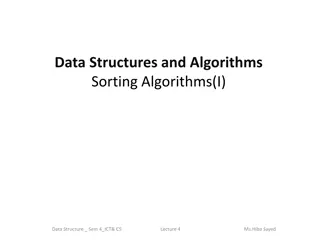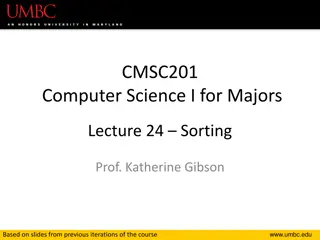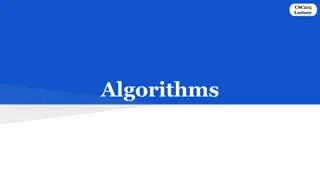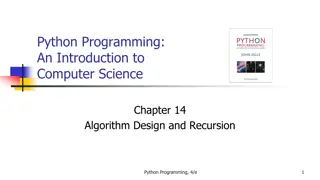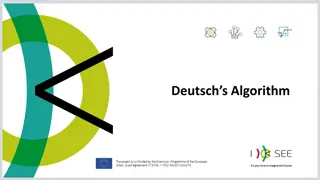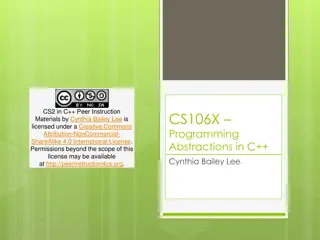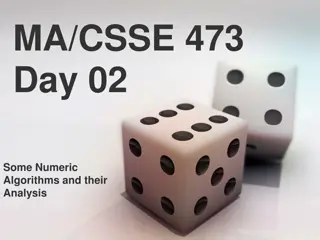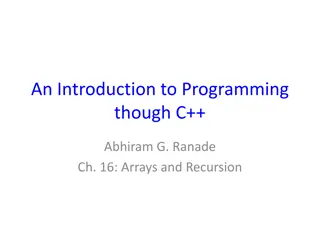Algorithm Analysis
Algorithm analysis involves evaluating the efficiency of algorithms through measures such as time and memory complexity. This analysis helps in comparing different algorithms, understanding how time scales with input size, and predicting performance as input size approaches infinity. Scaling analysi
1 views • 30 slides
Searching & Sorting Algorithms Overview
Explore various sorting and searching algorithms such as Linear Search, Binary Search, Bubble Sort, Selection Sort, and Insertion Sort. The provided content presents code snippets and explanations for each algorithm, illustrating their implementation in both C++ and generic pseudocode.
1 views • 10 slides
Understanding Booth's Algorithm for Binary Integer Division
Learn about Booth's Algorithm and how it facilitates binary integer division. Discover key points to remember when using the algorithm, steps to initiate the process, and a detailed example to illustrate the multiplication of two operands using Booth's Algorithm.
1 views • 42 slides
Understanding Stable Matchings and the Gale-Shapley Algorithm
The concept of stable matchings is explored, along with the Gale-Shapley algorithm for finding them efficiently. Key ideas and steps of the algorithm are explained, supported by visuals. The process, examples, and observations related to the algorithm's effectiveness are discussed, highlighting the
3 views • 29 slides
Ricart and Agrawala's Algorithm for Mutual Exclusion
The Ricart-Agrawala Algorithm is a distributed system algorithm for achieving mutual exclusion without the need for release messages, developed by Glenn Ricart and Ashok Agrawala. The algorithm involves processes sending timestamped requests to enter a critical section, with careful handling of repl
1 views • 16 slides
Understanding Algorithm Efficiency Analysis
In this chapter, Dr. Maram Bani Younes delves into the analysis of algorithm efficiency, focusing on aspects such as order of growth, best case scenarios, and empirical analysis of time efficiency. The dimensions of generality, simplicity, time efficiency, and space efficiency are explored, with a d
1 views • 28 slides
Understanding Lamport Algorithm for Mutual Exclusion
Lamport Algorithm, presented by Prafulla Santosh Patil, is a permission-based algorithm utilizing timestamps to order critical section requests and resolve conflicts. It employs three types of messages: REQUEST, REPLY, and RELEASE, where each site manages a queue to store requests. By ensuring commu
0 views • 15 slides
Understanding Sorting Algorithms: Bubble Sort and Insertion Sort
Master the concepts of standard sorting algorithms through a detailed exploration of Bubble Sort and Insertion Sort. Learn how each algorithm functions step-by-step, gaining a practical understanding of sorting techniques in computational thinking and programming. Engage in hands-on activities to ap
1 views • 14 slides
Digital Differential Analyzer (DDA) Algorithm in Computer Graphics
In computer graphics, the Digital Differential Analyzer (DDA) Algorithm is utilized as the basic line drawing algorithm. This method involves interpolation of variables between two endpoints to rasterize lines, triangles, and polygons efficiently. The algorithm requires inputting coordinates of two
0 views • 9 slides
Exploring Algorithm Design Approaches with Dr. Jey Veerasamy
Discover a range of algorithm design approaches including quick-sort, merge-sort, divide and conquer characteristics, greedy approach, and solutions to various optimization problems such as petrol cost minimization, number of stops minimization, activity selection, and knapsack problem. Dive into th
0 views • 14 slides
Sorting Techniques: Complexity, Stability, and Cases
This content discusses various sorting techniques, their time complexity in worst, best, and average cases, stability, and types of sorts. It includes a comparison table listing algorithms such as Bubble Sort, Selection Sort, Insertion Sort, Quick Sort, and more, along with their respective complexi
0 views • 10 slides
Understanding Heap Sort in Data Structures
Heap Sort, a sorting algorithm based on the concept of a heap data structure, is explained in detail. The properties of a heap, its implementation using a complete binary tree, and its application in priority queues are discussed. The process of building a heap, inserting elements, and sorting them
0 views • 7 slides
Understanding Merge Sort Algorithm in Computer Science
Explore the concept of the merge sort algorithm as a practical example of tree recursion. Learn how merging works, the steps involved in the merge algorithm, and how recursive merge sort can efficiently sort unsorted lists. Dive into the recursive implementation of merge sort and grasp its recursive
0 views • 22 slides
Understanding Merge Sort: A Brief Overview of an Earlier Sorting Algorithm
History of the Merge Sort, its principles of divide and conquer, and visual representations of how the algorithm works through comparisons and sorting steps. Includes a hands-on example of applying Merge Sort to reorder a list of months.
0 views • 23 slides
Massively Parallel Sort-Merge Joins in Main Memory Multi-Core Database Systems
Explore the hardware trends and techniques used at Technische Universität München for massively parallel sort-merge joins in main memory multi-core database systems. The research focuses on exploiting fast main memory access, parallelizing algorithms, and optimizing performance in a NUMA environme
0 views • 29 slides
Comprehensive Overview of Sorting Algorithms in Computer Science
Explore the intricacies of various sorting algorithms like Shell Sort, Merge Sort, and Quicksort through examples, pseudocode, and analysis. Get ready for an upcoming test with sample problems and revision sessions. Don't miss the deadlines for homework submissions and participation. Dive into the w
0 views • 59 slides
Algorithm Design Techniques: Divide and Conquer
Algorithm design techniques such as divide and conquer, dynamic programming, and greedy algorithms are essential for solving complex problems by breaking them down into smaller sub-problems and combining their solutions. Divide and conquer involves breaking a problem into unrelated sub-problems, sol
1 views • 13 slides
Introduction to Divide and Conquer Algorithms
Explore the Divide and Conquer method in algorithm design, focusing on Mergesort as a fast sorting recursive algorithm. Learn how to divide input into smaller parts, solve them recursively, and merge the results to obtain the final solution. Dive into the key ideas, steps, and intricacies of Merge o
2 views • 59 slides
Understanding Bubble Sort Algorithm
This content explains the Bubble Sort algorithm, discussing its working principle through examples and code. It covers the process of sorting elements, visual representations, time complexity analysis, and ways to improve sorting efficiency through different techniques.
0 views • 53 slides
Grey Wolf Optimizer: A Nature-Inspired Optimization Algorithm
The Grey Wolf Optimizer algorithm is based on the social hierarchy of grey wolves in the wild. Inspired by the pack behavior of grey wolves, this algorithm utilizes alpha, beta, and delta solutions to guide the optimization process. The hunting phases of tracking, pursuing, and attacking prey mimic
3 views • 16 slides
Emergency Paediatric Tracheostomy Management Algorithm
Emergency Paediatric Tracheostomy Management Algorithm provides a structured approach for managing pediatric patients requiring tracheostomy in emergency situations. The algorithm outlines steps for assessing airway patency, performing suction, and changing the tracheostomy tube if necessary. It emp
0 views • 4 slides
Development of Satellite Passive Microwave Snowfall Detection Algorithm
This study focuses on the development of a satellite passive microwave snowfall detection algorithm, highlighting the challenges in accurately determining snowfall using satellite instruments. The algorithm uses data from AMSU/MHS, ATMS, and SSMIS sensors to generate snowfall rate estimates, overcom
0 views • 20 slides
Understanding Euclid's Algorithm: An Ancient Approach to Finding Greatest Common Divisors
Euclid's Algorithm, dating back 2500 years, offers a simpler method to find the greatest common divisor (gcd) of two non-negative integers compared to traditional factorization. By iteratively applying a rule based on the gcd of remainders, it efficiently computes gcd values. The basis of the algori
0 views • 15 slides
Understanding Binary Radix Sort for Efficient Data Sorting
Explore the concept of Binary Radix Sort explained through sorting punch cards into order with a pencil. Learn how to efficiently sort data using divide and conquer techniques based on binary numbers. Discover the practical ways to teach computing and computational thinking without relying on comput
0 views • 13 slides
Divide and Conquer Algorithms - Dr. Maram Bani Younes
This chapter on divide and conquer algorithms introduces key concepts such as dividing the problem into smaller subproblems, solving them, and combining the solutions. It covers techniques like finding maximum and minimum elements, maximum contiguous subsequence sum, binary search, quick sort, merge
1 views • 30 slides
Exploring Bubble Sort Algorithm for Teaching Computing Concepts
Dive into the world of sort algorithms with a focus on bubble sort, its efficiency, and computational thinking. Discover practical ways to teach computing concepts in a fun and engaging manner. Explore the process of bubble sort, learn how to compare and swap array elements, and understand the impor
0 views • 19 slides
Understanding Bubble Sort Algorithm - COEN 352 by Tawfiq Jawhar
Dive into the world of sorting algorithms with a focus on Bubble Sort. Explore how Bubble Sort works through animations, visual representations, and explanations of its time complexity, stability, and in-place nature. Discover the significance of one iteration in Bubble Sort and how it affects the a
0 views • 17 slides
Introduction to Algorithms and Sorting Techniques
Brute force and exhaustive search are fundamental problem-solving approaches in algorithm design, while selection sort and bubble sort are common sorting techniques. Brute force involves solving problems directly based on the problem statement, with the computer carrying out the computations. Select
0 views • 18 slides
Overview of Sorting Algorithms
Explore the world of sorting algorithms through a detailed lesson outline covering popular methods like Bubble Sort, Selection Sort, and Quick Sort. Learn how to sort an array, understand the time complexity of different sorting techniques, and discover the intricacies of implementation through code
0 views • 53 slides
Introduction to Bubble Sort Algorithm
Bubble sort is a simple comparison-based sorting algorithm that repeatedly compares adjacent elements and swaps them if they are in the wrong order. It is easy to implement but inefficient for large datasets. The algorithm iterates through the list multiple times until no more swaps are needed, ensu
0 views • 16 slides
Understanding Sorting Algorithms in Computer Science
Delve into the world of sorting algorithms in computer science with a focus on Selection Sort, Bubble Sort, Quick Sort, and Radix Sort. Learn how sorting impacts the efficiency of other algorithms and explore the scalability of different sorting methods. Discover the importance of sorting algorithms
0 views • 37 slides
Overview of Sorting Algorithms and Quadratic Sorting - CS 330 Lecture Notes
Sorting algorithms play a crucial role in computer science and computing tasks, consuming a significant portion of computing power. Various algorithms such as Bubble Sort, Selection Sort, and Insertion Sort are discussed for sorting a list of values efficiently. Quadratic sorting algorithms like Sel
0 views • 30 slides
Exploring Divide and Conquer Paradigm in Algorithm Design
Discover the Divide and Conquer approach in algorithm design through concepts like Merge Sort and Counting Inversions. Learn how to split instances into subparts, solve them recursively, and combine the answers to optimize algorithm efficiency.
1 views • 43 slides
Introduction to Basic Algorithms: Searching and Sorting
Explore the fundamentals of basic algorithms focusing on searching and sorting techniques. Learn about linear (sequential) search, sorting problem complexities, and popular algorithms like Bubble Sort and Selection Sort. Discover the key concepts, terms, and functions involved in search and sort alg
0 views • 15 slides
Understanding Efficiency and Search Algorithms in Python Programming
This chapter introduces the basics of algorithm efficiency analysis, searching techniques such as linear and binary search, recursive definitions and functions, sorting algorithms like selection sort and merge sort, and the importance of algorithm analysis in determining problem intractability. The
0 views • 134 slides
Stable Matching Problem and Gale-Shapley Algorithm Overview
The content provides information on the stable matching problem and the Gale-Shapley algorithm. It covers the definition of stable matching, the workings of the Gale-Shapley algorithm, tips for algorithm implementation, and common questions related to the topic. The content also includes a summary o
0 views • 16 slides
Understanding Deutsch's Algorithm in Quantum Computing
Deutsch's Algorithm is a fundamental quantum algorithm designed to solve the problem of determining if a given function is constant or balanced. This algorithm leverages quantum principles such as superposition and entanglement to provide a more efficient solution compared to classical methods. By e
0 views • 17 slides
Understanding Recursion and Sorting Algorithms in C++ Peer Instruction Materials
Explore the Traveling Salesman Problem, recursive sorting techniques like Merge Sort and Quick Sort, and the challenges of mapping algorithms versus human perception. Delve into the importance of Selection Sort and scenarios of worst vs. best cases in algorithms.
0 views • 23 slides
Understanding Numeric Algorithms and Their Analysis
Explore the world of numeric algorithms and their analysis through various examples such as Fibonacci numbers, arithmetic algorithms, and the Master Theorem for Divide and Conquer recurrence relations. Delve into the intricacies of algorithm design processes and Levitin's algorithm picture. Gain ins
0 views • 13 slides
Introduction to Arrays and Recursion in C++
Arrays and recursion play a vital role in designing algorithms on sequences in programming. This introduction covers the implementation of searching in arrays, binary search, merge sort, and the concept of searching in sorted arrays using recursion. The use of recursion helps reduce comparisons and
0 views • 49 slides







